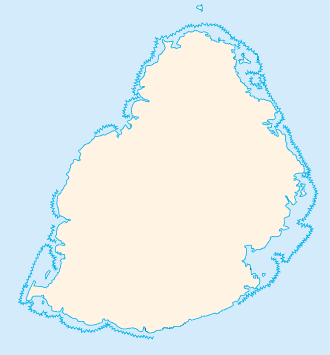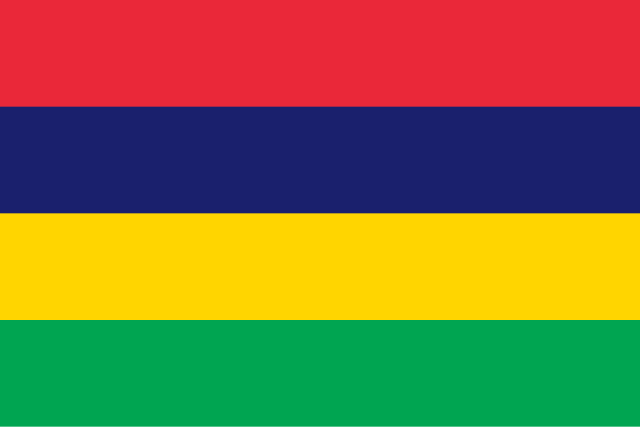Mauritius Military Power Ranking 2025
MPR Rank: 160th
MPR SCORE: 165
MPR Index: 0.0269 (1.0000 is perfect)
Reverse MPR Index: 0.9222 (0.0000 is perfect)
Z Score: -0.752 (standard deviations above the mean)
Overview
Mauritius ranks 160th in the 2025 Military Power Rankings. The country does not maintain a conventional military, instead relying on the Mauritius Police Force (MPF) for national security. Key paramilitary branches of the MPF include the Special Mobile Force (SMF) and the National Coast Guard (NCG), which together fulfill roles traditionally assigned to armed forces—namely internal defense, maritime security, disaster response, and public order.
Mauritius is widely recognized as one of the most peaceful nations in the Indian Ocean, with a defense doctrine based on neutrality, regional stability, and maritime law enforcement. The country participates in regional security partnerships and maintains bilateral defense ties with India, France, and the United States, particularly for coastal surveillance and counter-narcotics operations.
Military Strengths
Mauritius’s strengths lie in its domestic stability, paramilitary professionalism, and strategic maritime monitoring capabilities.
1. Internal Security Through Paramilitary Units
The Special Mobile Force (SMF) functions as a light infantry and riot control unit, trained for emergency response, counterterrorism, and natural disaster operations.
Operates under a military-style command structure within the Mauritius Police Force, with support from the Special Support Unit (SSU) and Police Helicopter Squadron.
2. Maritime Security Through National Coast Guard
The National Coast Guard (NCG) patrols Mauritius’s Exclusive Economic Zone (EEZ), engaging in anti-smuggling, fisheries enforcement, and search and rescue missions.
Operates fast interceptor boats, coastal patrol vessels, and radar-equipped monitoring stations across the main island and outer territories.
3. Disaster and Crisis Response Capabilities
Mauritius deploys rapid response teams for cyclones, floods, and oil spills, with the SMF playing a vital role in evacuation, logistics, and infrastructure protection during emergencies.
4. Strategic Partnerships and Training Cooperation
Maintains close defense cooperation with India, which provides naval patrol support, training, and joint exercises.
France, through its Indian Ocean territories, offers interoperability drills, naval exchanges, and aerial surveillance collaboration.
Participates in regional maritime forums such as the Indian Ocean Rim Association (IORA) and ASEAN Regional Forum (ARF).
Why Mauritius Is Ranked 160th
No Standing Army or Conventional Force Structure
Mauritius does not field a national military, relying entirely on police-based paramilitary units for territorial defense and public security.No Air Force or Heavy Weaponry
While the country maintains light helicopters, there are no combat aircraft, tanks, or artillery systems in service.Limited Independent Deterrence Capacity
National defense depends on diplomacy, law enforcement, and bilateral military assistance, not on force projection or strategic deterrence.Small Personnel Base and Modest Budget
With a total active security force of under 10,000 personnel, Mauritius focuses on policing, civil protection, and surveillance, rather than military engagement.
Conclusion
Mauritius exemplifies a non-militarized security model, relying on well-organized paramilitary forces to ensure national sovereignty, public safety, and maritime law enforcement. While it ranks low in terms of conventional military capacity, its role in Indian Ocean maritime stability, disaster response, and regional security cooperation is noteworthy. The country’s MPR score reflects the absence of a traditional armed force, counterbalanced by a disciplined internal security apparatus and effective bilateral defense networks.
Military Strength and Force Projection
Active Security Personnel: 2,500 (including paramilitary forces)
Reserve Personnel: 500
Paramilitary Forces: 1,000+ (Special Mobile Force, Police Tactical Unit)
Army Personnel: 0 (no traditional army)
Navy Personnel (Coast Guard): 800
Air Wing Personnel: 200
Ground Forces
Main Battle Tanks (MBTs): 0
Armored Fighting Vehicles (AFVs): 10+
Artillery Pieces (Towed & Self-Propelled): 0
Multiple Launch Rocket Systems (MLRS): 0
Air Force (Police Air Wing)
Combat Aircraft: 0
Attack Helicopters: 0
Transport Aircraft: 2+
Surveillance Aircraft: 2+
Aircraft Breakdown:
Dornier Do-228 and Defender aircraft for coastal surveillance
HAL Dhruv and other utility helicopters for disaster and policing support
Naval Forces (National Coast Guard)
Warships: 6+
Submarines: 0
Frigates/Corvettes: 0
Patrol Boats: 6+
Naval Vessel Breakdown:
Barracuda-class OPV (Indian-built)
Fast patrol boats for EEZ and anti-smuggling missions
Maritime enforcement is a national priority
Missile Capabilities
Mauritius does not possess missile systems. Defense operations are limited to small arms, naval patrol craft, and aerial surveillance. There are no ballistic, cruise, or guided missile capabilities.
Strategic Partnerships
Mauritius has strong security partnerships with India, France, and the United States, focused on maritime domain awareness, anti-piracy, and surveillance. It is part of the Indian Ocean Rim Association and hosts joint exercises to enhance coastal security and EEZ enforcement.
Military History & Combat Experience
Mauritius has no record of armed conflict or conventional warfare, with its security institutions focused on internal resilience, colonial transition, and regional cooperation.
Colonial Military Presence (Pre-1968):
Under British colonial rule, Mauritius hosted British garrisons and naval facilities, but maintained no indigenous armed forces. Defense was the responsibility of the Royal Navy and British Indian Army detachments.Post-Independence Security Structure (1968–Present):
Following independence in 1968, Mauritius chose not to establish a standing army. Instead, the Special Mobile Force (SMF) was created from former British troops, trained and equipped to handle riot control, national emergencies, and internal threats.Peacekeeping and Regional Collaboration:
While Mauritius has not participated in combat operations abroad, its officers have been involved in observer missions, disaster response coordination, and UN civilian security programs in Africa and Asia.Piracy and Maritime Monitoring (2000s–Present):
Rising piracy off the Horn of Africa and in the Mozambique Channel prompted Mauritius to strengthen its maritime security protocols, including joint patrols, coastal radar systems, and cooperation with U.S. AFRICOM, France, and India.
The NCG has engaged in anti-narcotics interdictions, illegal fishing seizures, and humanitarian rescues in the region.
Mauritius remains one of the few countries without a formal military, yet continues to demonstrate a well-coordinated, professional internal security framework rooted in law enforcement, regional diplomacy, and civil resilience.
General Information
Demographics and Geography
Population: ~1.3 million (2024 est.)
Population Available for Military Service: ~550,000
Geographic Area: 2,040 km²
Land Boundaries: 0 km
Bordering Countries: None (island nation)
Coastline: 177 km
Climate: Tropical maritime; warm, humid summers and cool, dry winters
Terrain: Small coastal plain rising to central plateau; encircled by discontinuous mountains
Natural Resources: Arable land, fish, potential offshore hydrocarbons
Proven Oil Reserves: None (exploration inconclusive)
Proven Natural Gas Reserves: None
Economic Indicators
Defense Budget (2025): ~$90 million USD
Defense Budget as % of GDP: ~1.2%
GDP (PPP): ~$35 billion USD
GDP per Capita (PPP): ~$27,000
External Debt: ~$8.2 billion USD
Military Expenditure Trend (last 5 years): Relatively flat, with increases focused on maritime surveillance and counter-narcotics
Military Infrastructure and Readiness
Military Service Obligation: Voluntary
Primary Defense Focus: Maritime security, law enforcement, disaster response
Military Industry Base: None; relies on imported equipment and maintenance
Cyber/Electronic Warfare Capability: Emerging; focused on national cybersecurity
Nuclear Warhead Inventory: None (non-nuclear state)
Major Military Districts / Commands: Mauritius Police Force oversees the Special Mobile Force and National Coast Guard
Missile Inventory Highlights: None; small arms and light naval weapons only
Reservist Call-up Readiness / Timeline: Moderate; ~30–60 days
Reservist Force Size: ~2,000
Space, Intelligence, and Strategic Infrastructure
Space or Satellite Programs: Minimal; launched MIR-SAT1 (nano-satellite) in 2021
Military Satellite Inventory: None
Intelligence Infrastructure: National Intelligence Unit (NIU), operating under Prime Minister’s Office
Intelligence Sharing Partnerships: India, France, United States
Airports (Total): ~5
Major Military Airports: Sir Seewoosagur Ramgoolam International Airport (dual-use)
Naval Power and Maritime Logistics
Merchant Marine Fleet: Small, regionally focused
Major Ports: Port Louis
Naval Infrastructure: National Coast Guard and patrol fleet
Naval Replenishment Capability: Basic offshore patrol support capability
Domestic Mobility and Infrastructure
Railway Network: None (historically dismantled)
Roadways: ~2,700 km
Energy and Fuel Logistics
Oil Production: None
Energy Imports: Fully reliant on imports
Strategic Petroleum Reserves: Low
Defense Production and Strategic Forces
Domestic Defense Production: None
Military Installations (Domestic): Vacoas, Port Louis, Rodrigues
Military Installations (Overseas): None
Foreign Military Personnel Presence: Limited presence via India and France for naval cooperation
Defense Alliances: Bilateral defense cooperation with India, France, and the United States
Strategic Airlift Capability: None; relies on international partnerships
Wartime Industrial Surge Capacity: Extremely low
Research and Industry Support
Defense R&D Investment: None
Key Wartime Industries Beyond Defense: Sugar and seafood processing, port and air logistics
Political and Administrative Structure
Capital: Port Louis
Founding Date: March 12, 1968 (independence from the UK)
System of Government: Parliamentary republic



